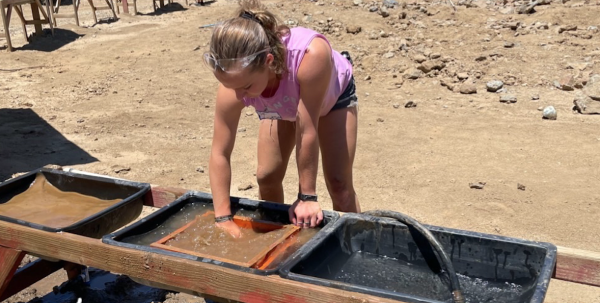KID REPORTERS’ NOTEBOOK
Mining Benitoite
This 34-carat benitoite is the largest gem ever found at the Benitoite Mining Company in Coalinga, California.
Deep in the hills of Coalinga, California, members of the public can dig for benitoite, the rarest gem on Earth. The Benitoite Mining Company transports dirt by dump truck directly from a hidden mine. In order to protect its location, the mine is not accessible to members of the public. The dirt is unloaded onto an empty field on the site of what was once a prison.
Benitoite is made of a blue-colored crystal. Under a shortwave ultraviolet (UV) light, the gem glows a bright blue to bluish white. That is the chief way “rock hounds,” or collectors, can identify it. The mineral can be visually identified by its glassy, blue color and double triangle shape.
“THE THRILL OF THE HUNT”
Visitors to the site are given a quart-size bag for the treasures they find throughout the day. An estimated one in 20 visitors walks away with a valuable gem.
After all of the hard work, “the best part was the thrill of the hunt,” said Keri Bean, a rock enthusiast from Pasadena. “It paid off at the end of the day with some beautiful rocks and small gems to add to my rock collection.”

Ella talks with John Schreiner (left) and his father, Dave Schreiner, who are the owners of the Benitoite Mining Company.
CALIORNIA’S STATE GEM
James M. Couch discovered benitoite more than a century ago, in 1906. He thought he had found sapphires. However, John Schreiner, the co-owner of the Benitoite Mining Company, explained that the discovery was actually “a new gemstone that had never been found before.”
The gem got its name from its proximity to California’s San Benito River. In 1985, benitoite became the official state gem of California.
Scheriner and his family purchased the mine in 2005. Their goal was to open it up for public digs. “Many people who come to dig know very little about the gemstone,” Schreiner said. “Everyone has heard of diamonds, but almost no one knows about benitoite.”
The company employs a small team of workers who mine during the week. The gems they find are cut and sold for jewelry. Benitoite is currently valued at about $4,000 per carat.
“The largest benitoite we’ve ever found was 34 carats,” Schreiner said. "It was cut into four different benitoite gemstones. The largest one was just over eight carats. It ended up being the fourth-largest cut of benitoite in the world.”

Ella demonstrates how the wooden boxes at the mine are washed.
THE MINING EXPERIENCE
On its website, the company describes benitoite as having “more fire and brilliance than a diamond.” This intrigues rock collectors like Bean. “I learned about the mine while I was researching places online to rockhound in California,” she said. “Hearing about benitoite and how rare it is and how pretty it is made me want to visit.”
Every Saturday, from 9 a.m. to 3 p.m., participants with reservations are welcomed onto the property for a mining experience. Upon arrival at the camp, visitors are greeted by a staff member who conducts a brief tour of the historic prison.
At the piles of dirt, visitors are shown how to dig, sift, wash, and identify gems. They fill a wooden screen box with mining materials. Next, they sift the box vigorously to remove the loose dirt from the screen.
”The hardest part was sifting the rocks out of the dirt,” Bean said. “Shaking the sifter back and forth so much wore out my arms.”
After the rocks are thoroughly cleaned in three washbins, they are ready for sorting. Two rooms are set up with shortwave UV light stations, and the screen of clean materials is placed under the light. The rocks that glow are benitoite.
After several trips back and forth, the quart-size bags begin to fill up with treasures. At the end of the mining experience, the bag is examined by a staff member for the most impressive pieces.
“I found a few small gems that were too small to use for jewelry,” Bean said. “But I did find one rock that had larger benitoite gems embedded inside. It will now proudly sit on display on my rock collection shelves.”
